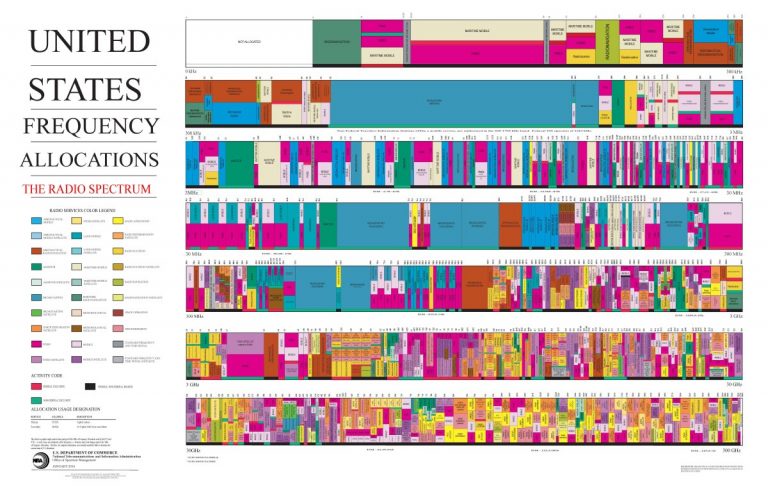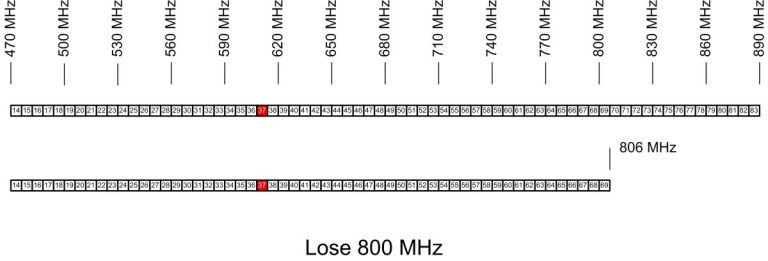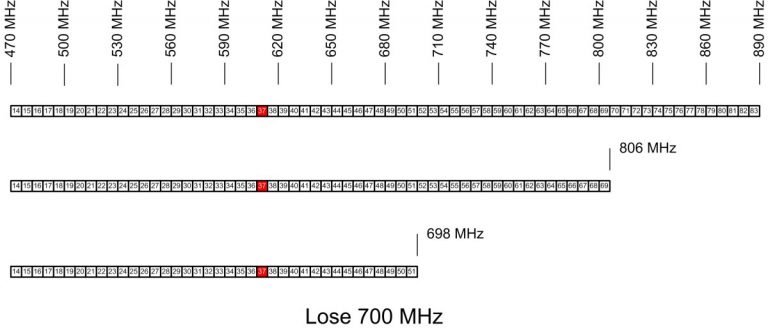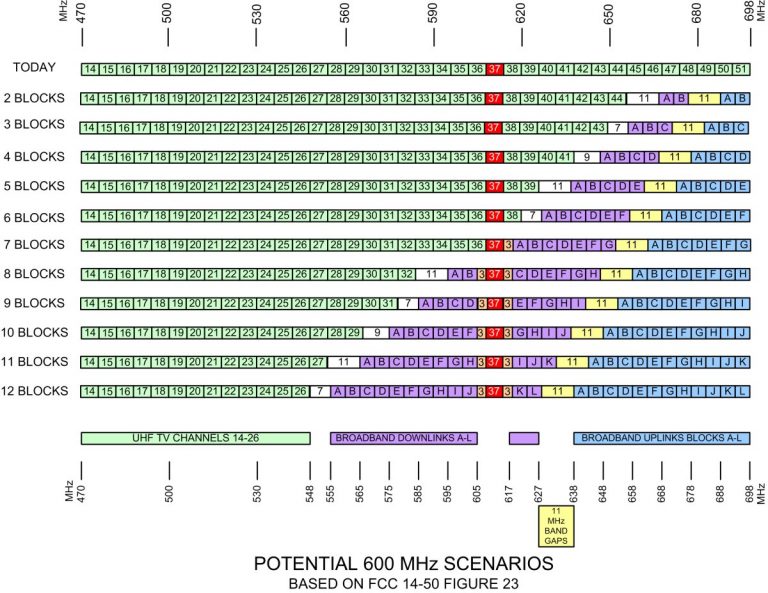The Radio Frequency Spectrum Puzzle – PART 1
by Bill Ruck, San Francisco Broadcast Engineer
In order to understand what is happening with the UHF television band and how it has an impact on the use of this band for wireless microphones, one needs to take a look at several different aspects of the situation.
THE RADIO FREQUENCY SPECTRUM
The Radio Frequency (RF) spectrum is generally considered the band of electromagnetic energy from 3 KHz to 300 GHz. For the first forty years or so, only the lower frequencies were considered useful, and frequencies above about 30 Mc/s (the older term “Megacycles per second”) were considered “useless.” However, developments in the 1930s and especially the technology developed during World War II, expanded the useful spectrum through the microwave frequencies. By about 1970, almost the entire radio frequency spectrum was allocated to some use.

The important picture is that there are no unused bands of frequencies shown on Figure 1. Any new use of RF has to take spectrum away from someone else. The rest of this article will describe how cellular telephones and wireless personal devices have been taking RF spectrum away from traditional RF uses.
TELEVISION HISTORY
In the 1930s, television experiments were demonstrated and proponents were asking the FCC to allow them to begin transmitting pictures to the public. The Radio Manufacturers Association (RMA) proposed a television standard but not everyone accepted the standard. Finally, the FCC declared that until there is a nationwide standard, there would be no public television.

The National Television System Committee (NTSC) was formed in July 1940 to create such a standard. Meetings were held and every part of television broadcasting was reviewed. In March 1941, an FCC hearing was held and a consensus standard presented by the NTSC. The FCC adopted those standards and allowed television broadcasting to start with what is known today as NTSC 525-line television.
Different incompatible television channel plans had been proposed but in April 1941, eighteen television channels were assigned in low-band VHF (50 MHz–108 MHz) and high-band VHF (162 MHz–294 MHz).
World War II stopped all television progress as all of the VHF and UHF bands were assigned to the military for “the war effort” and consumer manufacturing was converted to military needs. After the war ended, the TV channel plan was changed again to make space for high-band VHF FM broadcast 88 MHz–108 MHz, leaving thirteen television channels in lowband and high-band VHF. The FCC was also pressured to make more frequencies available for land mobile communications so television Channel 1 (44 MHz–50 MHz) was taken away from broadcasting and assigned to land mobile communications. That’s why with the exception of the very first-generation television sets, all US televisions start at Channel 2.
Very quickly, TV stations went on the air and the thirteen channels were filled in major cities. Around 1950, the military returned most of the UHF spectrum to civilian use and in 1952, UHF TV Channels 14 (470 MHz–476 MHz) through Channel 83 (884 MHz–890 MHz) were made available for television.
Note that UHF TV Channel 37 is reserved through international agreement for astronomical radio telescopes. No high-power transmitter is allowed on this channel to protect those observations.
UHF TV stations had a problem because TV receivers only received VHF TV Channels 2–13. To receive any of the UHF channels, one needed to purchase a special “set top” converter. This required user-proficiency because the UHF tuner didn’t have click stops and the user had to carefully tune in the UHF channel. Generally, TV antennas were VHF only and did not pick up UHF stations well. Another problem was that the UHF band had a lot more loss and first-generation UHF television transmitters had relatively low power.
Many new UHF stations went broke in a year or two and disappeared because viewers were unable to find the stations and without an audience, the station had no cash flow.
Finally, Congress passed the All-Channel Receiver Act of 1962. It required all television set manufacturers to include built-in UHF tuners in television receivers sold after 1964. Gradually, more television sets could receive UHF channels and with improvements in UHF transmitters for much higher power, UHF TV stations started to gain an audience and stay in business.
“T BAND”
By the mid-1960s, in many major metropolitan areas, land mobile communications, both public safety and industry and business, completely filled the available radio spectrum and started to pressure the FCC to make additional spectrum for their purposes. They proposed that several “unused” UHF TV channels be reassigned to land mobile communications. Finally, the FCC issued a Report and Order in May 1970 and in thirteen metropolitan areas, UHF TV channels were reassigned to land mobile communications. Since that time, there have been many rule makings fine-tuning the use of UHF TV frequencies in those areas.
“800 MHZ”
Two different forces converged to get the FCC to reassign UHF TV spectrum. The first was land mobile communications, which needed even more spectrum for their needs and the second was a new service called “Cellular Telephones.” They proposed to the FCC that the upper UHF TV channels were lightly used and could be reassigned for their purposes. The FCC ultimately agreed and effective October 18, 1982, reassigned UHF TV Channels 70 (806 MHz–812 MHz) through Channel 83 (884 MHz–890 MHz) to these purposes. Because there were only a few UHF TV stations operating in these channels and there was plenty of otherwise unused UHF TV spectrum, this had little impact on television broadcasting.
Figure 3 shows the upper channels lost to UHF TV.

DIGITAL TELEVISION
In the 1980s, television set manufacturers started clamoring for “digital television.” Their goal was to make all of the television receivers in the United States obsolete and sell new ones to consumers. Television broadcasters pushed back because (1) none of the proposed digital television systems actually worked; (2) it was going to cost stations lots of money to convert; (3) television stations realized that they could not charge more for a commercial delivered digitally; and (4) until the majority of viewers had new digital television sets, they would have no audience.
It became obvious that a nationwide standard needed to be adopted. The manufacturers remembered the Beta vs. VHS debate and did not want to go through incompatible systems again. So the Advanced Television Systems Committee (ATSC) was created in 1982 to take the competing digital systems and create a consensus standard. Ultimately, what is called the “Grand Alliance,” developed a specification for what is known today as “ATSC 1.0.” This standard included standard-definition format (NTSC) as well as high-definition (HDTV) standards. HDTV allowed a widescreen 16:9 image with about six times the resolution of NTSC.
The problem now was convincing the television broadcasters to convert to digital. In 1996, Congress authorized the distribution of an additional broadcast channel to every full-power TV station so that each station could launch a digital broadcast channel while simultaneously continuing analog broadcasting. Existing analog NTSC stations could have a second digital ATSC channel until enough digital receivers were in use in the United States. When this process was over, the television industry had to give up about 100 MHz of spectrum, the “700 MHz band” from Channel 52 to Channel 69. This process took a lot longer than expected partially because the new digital transmission and reception technology had to be developed, new transmission systems had to be purchased and installed (at a typical station cost in the range of $1 million), and viewers had to purchase new digital ATSC receivers. The viewers had some help in that free converters were made available to the public funded by the sale of the “700 MHz band.”
Originally, the transition date was February 2007 but it was clear at that time that not enough TV stations were ready to transmit digital and not enough viewers were ready to receive digital TV. The date was extended several times and finally on June 12, 2009, digital ATSC replaced analog NTSC throughout the United States. When this happened, the UHF television band was reduced to Channel 14 through Channel 51. But the carriers started to complain about interference from Channel 51 so TV stations on this channel had to move to another unused TV channel. Although Channel 51 still exists, in practice it is not used by TV stations.
Figure 4 shows the UHF TV spectrum as it exists today in 2016.

THE SPECTRUM ACT OF 2012
Buried in the Middle Class Tax Relief and Job Creation Act of 2012, Congress directed the FCC to sell about 100 MHz of the UHF TV band, now commonly referred to as “600 MHz.” This legislation came as a complete surprise to the FCC, the broadcast industry and the mobile carriers.
Since that time, there has been considerable debate over exactly how this can be done and how this should be done. There are competing issues at stake. First, enough UHF TV channels must be cleared of existing television broadcasters nationwide to make a nationwide block of frequencies available to carriers. Second, new channels have to be found for these TV stations to move to. Third, the block of frequencies must be sold at a high-enough price to pay the TV station’s cost to move and leave a profit to the United States.
Keep in mind that the Spectrum Act requires that the auction provide positive cash flow to the US Treasury. Not all FCC spectrum auctions have been successful. In this case, if the UHF TV stations demand premium dollars for their channels and the carriers hold back, the auction fails. Then the FCC has to revise its plan unless Congress changes the law. When this is over, a significant amount of UHF TV spectrum will be lost and it is likely that there will be no “unused” UHF TV channels.
WHITE SPACES
Several groups, including Microsoft, Google, Dell, HP, Intel, Philips, Earthlink and Samsung, proposed technology to use “unused” UHF TV channels for high-speed Internet access. These devices were termed “White Space Devices” (WSD).
After testing and lawsuits, the FCC approved the unlicensed use of white space on November 4, 2008. However, there were several limits imposed on the use of WSD that has limited their use. The major issue is that after the 700 MHz band was taken from broadcasting, there were few unused UHF TV channels or “White Spaces” left. Because these devices are unlicensed, FCC Rules require that they must operate without interference to licensed devices. The FCC mandated a system where licensed users and locations that use Broadcast Auxiliary Services like theaters or sports complexes can register that location and TV channel and all WSD in that area must shut down. While there have been a few demonstration systems installed, in general, WSD is a dead issue with no profitable business model.
ATSC 3.0
The digital television standard now in use is about twenty years old. Technology has greatly improved since that time and today there is an active research effort to define improved television quality with a new standard. Higher definition video, known as “4K,” and an improved RF transmission system known as “COFDM,” has been proposed. However, the proposed standard, termed “ATSC 3.0,” is incompatible with the existing system and exactly how the US can transition to a completely new television transmission system has not been decided. The primary obstacle is that there are no “unused” UHF television channels today and after the 600 MHz band is taken away, it will be even more difficult to make the transition.
THE MOBILE TELEPHONE INDUSTRY
There have been mobile telephones since the 1950s. The first generation of mobile telephones used land mobile technology with high-level transmitters. This limited the number of mobile telephone users in any area. The hardware itself was large and required a lot of electrical power so the use was limited to automobiles.
In spite of the problems, there was considerable demand for mobile telephones by the 1960s. A user had to wait a considerable amount of time for a channel to become available to use their mobile telephone and because the number of users was limited, there was also a long waiting list of prospective users that wanted a mobile telephone number. Engineers at Bell Labs came up with a completely different type of mobile telephone system, which instead of high-level transmitters, used a network of low-level transmitters. The goal of this system was frequency reuse so that more active mobile telephone users could be accommodated in limited spectrum. A lot of intelligence was necessary to make this work, both at the network level and at the subscriber level because as one moved around, the call would be “handed off” to a different transmitter and frequency. Because diagrams of this system showed a neat arrangement of octagons, it became known as “cellular” telephones.
First-generation cellular telephones were analog and took advantage of 800 MHz spectrum taken away from UHF TV channels. Although the first-generation electronics were large enough to require trunk mounting in automobiles, the demand for these telephones was huge. The cellular providers quickly were behind in installing more and more network equipment to handle the demand.
Eventually, the network caught up with the demand and the service became highly profitable. Technology improved to the point where one could have a handheld cellular telephone. First-generation handheld cellular telephones were big and heavy and were known as a “brick” because they resembled a brick in size and weight.
The industry also recognized that they needed more spectrum to carry the demand so they petitioned the FCC to find more. The next generation of cellular systems was at a much higher frequency, around 1.8 GHz–2 GHz. Both US government stations and private microwave stations were relocated to other spectrum with the costs being paid by the carriers. These new cellular systems were digital and much more spectrum-efficient than the first-generation analog telephones.

The industry learned that the key to keeping up with the demand for capacity was to keep reducing the size of the cells. Today, one sees references to “micro-cells” and even smaller “pico-cells.” To make this happen, antennas must be designed to minimize coverage and the higher 1.8 GHz–2 GHz frequencies are preferred.
Also, the industry having completely converted to digital found itself providing data services as well as voice services. At first, short text messages were supported but as technology improved, full Internet access and email became available. Combined with much improved handsets, known as “smartphones,” a user today has much more communications ability than just making voice calls.
This also dramatically increased the need for capacity. The cellular industry simply cannot install new equipment fast enough to keep up with the demand. The industry continues to ask for more spectrum for additional capacity. They have learned that the higher frequencies work much better for small cells and are looking at frequencies up to 5 GHz.
But Congress, with the Spectrum Act of 2012, proposed to make 600 MHz available for this purpose. The lower frequency is not as attractive to the cellular industry for several reasons. The first reason is that the handheld antenna becomes too long to fit into today’s small handsets. The second reason is that the coverage is too good for efficient spectrum reuse. The third reason is that transmit antennas become much larger for equivalent performance than the higher preferred frequencies.
Exactly how the cellular industry will respond to the 600 MHz auction is not known. Already, one carrier, Sprint, declared that they would not participate in the auction.
The FCC has spent a lot of effort working on the auction and at the present time, no final road map for the auction has been proposed. They did publish a chart of potential frequency use, which has a range of potential scenarios from only two broadband blocks to twelve broadband blocks. The scenarios are messy because the broadband blocks are 5 MHz wide while TV channels are 6 MHz wide; TV Channel 37 must be protected; and the broadband blocks must have an 11 MHz guard band between the uplink and downlink blocks. Depending on the scenario, there is a minimum of 3 MHz of unused spectrum to a maximum of 11 MHz of spectrum that might be available for wireless microphones.
Figure 5 illustrates the complexity of the Spectrum Act’s requirements. The very top line shows the UHF TV spectrum as it exists today. But then the figure shows eleven different scenarios with two to twelve blocks becoming available for auction. What nobody knows today is how many UHF television stations will desire to sell their channel; how many carriers will bid on potential blocks; and what may be left for low-power auxiliary devices like wireless microphones. Since the downlink and uplink block pairs will be sold on a country-wide basis, the market with the fewest UHF TV stations that decide to sell out will define the scenario throughout the United States.
There is an active debate on whether the 11 MHz guard band will allow one UHF TV station to operate in the guard band. The carriers do not want a high-power UHF TV transmitter to interfere with their customers. There is also another guard band between downlink blocks and UHF TV channels. This is an attempt to reduce potential interference from nearby carriers’ transmitters and UHF TV reception. The guard bands have the potential for wireless microphones but one must consider that a nearby cell tower could make use of these guard bands for production very challenging.
Part 2 of “The Radio Frequency Spectrum Puzzle” will continue in the summer edition.